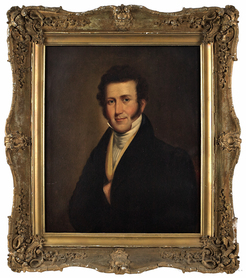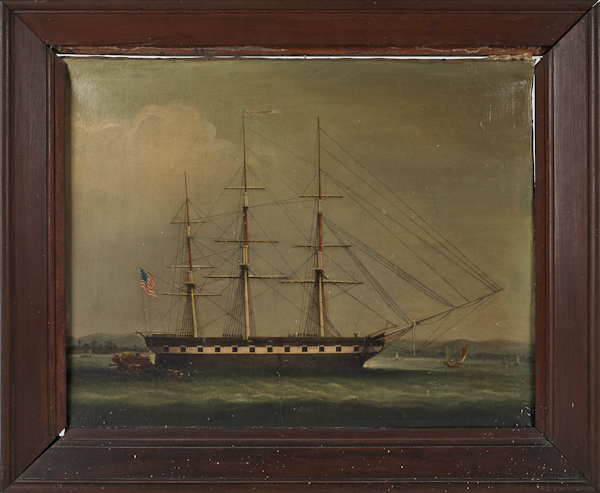Captain Hall J. Tibbits (American, 1797 to 1872)
This article about the life and career of Captain Tibbits by Eric C. Rodenberg appeared on the 4 November 2013 front page of Antique Week’s National Section. Used by permission. http://www.antiqueweek.com.
1800s Sea Captain’s Life Told Through Collection
At 6 foot, 4 inches tall and “powerfully built” Capt. Hall Jackson Tibbits would brook no foolishness.

After his “religious principles” were violated by passengers dancing on the main deck, he threatened to drive spikes into the deck “should such unholy practices continue.”
After a trip around Cape Horn, from New York to San Francisco soured and passengers began to complain, he threatened to fire the ship’s powder magazine and “blow it all to hell.”
Characterized by his detractors as “habitually intoxicated and mentally deranged,” the Captain suffered few complaints from passengers or crew.
After sending a “disease-racked” sailor aloft to the crow’s nest during a gale, a passenger idly commented that it was a wonder the sailor ever survived. “Aye,” said Capt. Tibbits. “I never have sick crewmen for long.”
Although Tibbits was normally a China trades shipper, the gold strike in California in 1849, proved to be a boon to business. And Capt. Tibbits was all about business.
In January of that year, the owners of the 532-ton square rigger Pacific, Tibbits and Frederick Griffing, advertised for passengers to make the “trip around the Horn,” leaving New York and arriving in San Francisco. It was a perilous three-to six-month journey, with tempestuous storms and gales rounding The Horn of South America, piracy and uncertainties at every port.
However, the genial Captain assured his first-class passengers that for $300, he would provide an ample table, comfortable “staterooms” and superlative service.”
However, Tibbits could not resist the temptation of “overbooking” the passage, particularly after he sold officials from the New England Mining and Trading Co. a block of staterooms for $275 each. Supposedly the passage was limited to 50 staterooms; however, 72 first-class tickets were sold, according to an account in Forty-Niners ‘Round the Horn by Charles R. Schultz.
Once the passengers learned they had been hoodwinked, they filed a lawsuit. But, Capt. Tibbets – not to be dry-docked by any lawyer – quietly slipped the Pacific out of New York in the late afternoon “to escape any further problems with the lawsuit.”
Many of cash-paying customers were left ashore, helplessly jumping and screaming. In the end, those left on land would count themselves fortunate.
“The first disillusionment experienced by the passengers aboard the Pacific was the attitude of one Capt. Tibbets, who trod the quarterdeck,” according to an account published in the Oakland Tribune. “The jovial mariner who previously extolled the service of his craft, the bounty of its table and the conveniences of travel aboard the ship, proved a relentless tyrant as soon as land was left behind.
“Thirty days out of New York, the passengers were miserable with seasickness and cold. Snow confined them in verminous quarters. The food consisted of raw mush, preserved meats, dubbed ‘old junk,’ and beans. Some of the passengers asked why pickles and vegetables were not served with meals, and the Captain blandly explained these items as being saved against the time when the passengers developed scurvy.”
Once the ship made port in Rio de Janerio, the passengers scurried to the U.S. Consulate with their allegations of cruel and inhumane treatment. Despite protesting vigorously against what he characterized as “the abuse of authority and the outrages committed upon me individually,” Tibbits was relieved of duty by the American Consul. Another captain was appointed to commandeer the ship the remainder of the journey. Tibbits was left aground in Brazil, according to a 1958 account by maritime historian W.Z. Gardner, and had to make his own way to San Francisco to re-claim his ship.
Although the debacle of the Pacific during his latter years of command left a black mark on the Captain’s legacy, he was widely regarded among his peers as a loyal old salt with an intimate knowledge of the seas.
Despite tyrannical tendencies, Capt. Tibbits was a true “son of the sea.” He went to sea young, with his father who captained a three-masted square-rigger running the China trade route from New York to Canton.
By the time of his father’s death, the 24-year-old Tibbits was one of the youngest shipmasters in the China trade. “Young Hall was physically strong, mentally alert and keenly interested in mastering the mysteries of navigation,” Gardner wrote.
During the ensuing years, Tibbits would own and command several clipper ships, trading tea and silk on a trade route between America, China and South America. He bought the Baltimore clipper ship, Architect, and after sailing it around the Horn discovered “she was too cranky and hard to handle,” according to son, George’s account, recorded by Gardner. In 1854, he sold the ship in Hong Kong, “at a considerable financial loss.” The favorite of the Captain’s ships was the Southerner, a three-masted, 670 ton ship which initially carried ten guns to discourage piracy. Built in 1834 in the shipyards of New York, she responded to the Captain’s subtle and learned touch until retiring in 1851.
But, the Southerner did not always carry Tibbits to “fair seas.”

“Four months before his son Robert was born (1840), the Captain was back on the Canton-New York run in the Southerner, according to Gardner’s account. “The Captain was saddled with a mutinous crew which seized the ship off the west coast of South America, near Chile, and put the Master ashore on an island. He was picked up by a passing ship bound for Canton.
Meanwhile, the Southerner was brought home and the Captain reported “lost at sea” by being swept overboard in a storm. His widow went into mourning, as was the custom, but did not re-marry. Four years later, Capt. Tibbits came home. His son, Robert, who had never seen his father until then, was considerably frightened and announced he “didn’t like that great big man.”
Trade with the Far Eastern Empire was lucrative in the era of 1830-1860, with Chinese furniture, silk and tea in high demand in the West. But the “price” was to be paid; engaging in the China trade was not for the faint-hearted. Trade and diplomatic relations between the Chinese and the West were fragile at best; at the worse, culminating in the Opium Wars (1839-1842 and 1857-1858).
In his latter years, his son George explained his father’s sea-born skill with a simple statement: “You have to have a ‘sense of the sea and of the sky.’ The Captain could tell a storm was coming three days in advance.”
After standing at the helm of the large three-masted square rigged ships of the high seas since 1821, the Captain – as many old salts – began to yearn for a more tranquil life in the country. In 1852, not quite the Ancient Mariner at 55 years old, the Captain bought a 127-acre farm on Sands Point, Long Island. Initially built by Capt. John Sands in the early 1700s, the house ultimately was expanded to 24 rooms. Nestled on the Atlantic shore, one of the Captain’s first projects was construction of a 90-foot porch fronting the ocean. During the next 20 years, Capt. Tibbits paced the porch, often posting himself behind a 3-foot-long telescope (marked Dolland, London, Day or Night) keeping vigil on his sea. When he moved into the old house, Tibbits brought with him an extensive collection of curios and paintings from his trips to China. He had a library full of sea-related literature and, as additional comfort, scattered around him the compass, chronometer, telescopes and barometer that had helped him navigate the globe for three decades. He also placed in his library a miniature folding writing desk, he used at sea, in addition to a large mahogany settee jettisoned from his quarters in the Southerner. Especially made to accommodate his large frame, the settee measured seven feet. Ship models made for him by crew members surrounded his home, in addition to several examples of exquisite Chinese craftsmanship in silk and ivory gathered during his travels. He also retained several antiques passed down through his family.
In 1872, the Captain died. His son, George, came from San Francisco to be with his mother. The home remained in the family until the spring of 1959 when it was sold. Prior to selling the home, all of Capt. Tibbit’s China Trade and nautical memorabilia were moved to a descendant’s home and large barn in Wading River, New York. There, it has remained for more than 50 years.
When Ron Pook, founder and owner of Pook and Pook Auctioneers and Appraisers come upon the China Trade trove, he was, at the least, stunned. “It was like stumbling onto a big time capsule; material piled up and virtually untouched for 150 years,” he said. “It’s unbelievable. This is the most important China Trade collection in existence. There hasn’t been one like it and, I’ll guarantee you, there won’t be another.” [It includes] the old nautical devices, Chinese art, the porcelain, ivory, sailors’ scrimshaw work, old leather-and-brass-tacked sea trunks (one with the name, Capt. Hall J. Tibbit), ship models, lacquered-veneer furniture – “it’s all there,” Pook said. Included among the items for sale are a portrait of the Captain and a painting of his favorite clipper, Southerner. Despite their age, both look as if they’re ready to sail again.
Information courtesy of Pook & Pook, Inc., January 2014.
